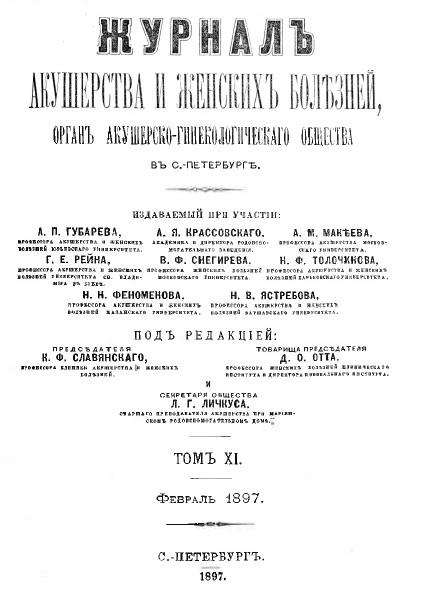Vol 11, No 2 (1897)
- Year: 1897
- Published: 13.02.1897
- Articles: 7
- URL: https://journals.eco-vector.com/jowd/issue/view/3288
- DOI: https://doi.org/10.17816/JOWD112
Full Issue
Articles
A case of malignant neoplasm, which has developed from the elements of the villous cover (Desidoma malignum autorum)
Abstract
In the last time, the attention of obstetricians, gynecologists and pathologists has been drawn to a special kind of neoplasm that primarily develops in the uterine cavity or tubes on the soil of a former normal or pathological pregnancy and is characterized by extreme malignancy.
 109-122
109-122


On the question of the choice between the conservative Caesar judgment and Roggo's operation. Conservative Caesar with a happy outcome for mother and fetus
Abstract
In No. 31 Centralblatt für Gynâcologie a case of Caesar's death according to Porro with a happy outcome for the mother and fetus from the Moscow clinic of prof. A. M. Makyeva. The author of this work priv. Assoc. Dr. Pobedinsky, presenting a very detailed description of the anamnesis, the patient's condition, data on the skeleton, the pregnant uterus and the pelvis, the course of the operation and in general terms the course and therapy of the post-natal period, expressed several provisions on this.
 123-135
123-135


Ulcus rotundum vaginas simplex
Abstract
Both primary neoplasms and vaginal ulcers are very rare. Between the latter, there is a form called Zahn'om for its resemblance to a round gastric ulcer Ulcus rotundum simplex vaginae. In view of that; that she is still very little known, I will allow myself to report a similar case.
 136-140
136-140


On the question of the so-called "pseudo-myxoma peritonei"
Abstract
Schroder in one of the first editions of his "guide to diseases of female genital organs", speaking of myxomatous ovarian cysts, expresses the opinion that these cysts, even more so, than the perforated papillary cysts, which are infectious for the peritoneal mucosa.
 141-150
141-150


A case of a cancroid of the clitoris and the upper third of the inner surface of the large dentary lips removed by surgery in the Gynecological Department at the Mogilev Obstetrics Department with the removal of all inguinal lymphatic glands
Abstract
Regarding the frequency of cancerous lesions of the external genital organs, they are, as always, in similar cases, to a known degree they are ambiguous; But all the same, on the basis of the available data, one can go to the conclusion that both in relation to other gynecological diseases, and in relation to cancer in other organs in general and in the genital organs in particular, cancer of the external genital organs is significantly aggravated.
 151-160
151-160


On the question of the treatment with electricity of some diseases of female genital organs
Abstract
Therapy of diseases of the female genital area, with the exception of surgical procedures, in essence, is very poor by its means. The reason for this is, on the one hand, in the fact that, due to special local anatomical conditions, it is difficult, and sometimes even impossible, to influence this therapeutic approach, which in other areas of our body, with the same pathological process, brings significant benefits.
 161-185
161-185


Preventive turn with narrow pelvis and its relation to the expectant method
Abstract
We now turn to the examination of the outcome of childbirth for mothers, both in the expectant method and in cases of preventive turn. Here we will observe traumatic injuries, feverish movements and their aftermath. For a more convenient comparison of the results, we decided to compare the data of 115 cases of the expectant method in parallel with the data of 60 cases of the preventive turn.
 186-208
186-208












